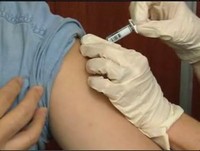Health Officials: Vaccine is Best Protection against H1N1
The only thing experts can say for sure about this flu season is that it won't be similar to any other. There will be multiple flu viruses circulating, one of which most people are defenseless against. "This year we are in uncharted territory," says Centers for Disease Control and Prevention director Thomas Frieden. "What will happen in the coming weeks and months will only become clear in the weeks and months ahead." Here is a handy guide to prepare for flu season by USA TODAY's Steve Sternberg, compiled from information provided by the CDC and other sources.

Novel H1N1 (swine flu) is an influenza virus that has never been seen in humans before and is spreading around the world. On June 11, the World Health Organization issued its highest form of global public health alert when it labeled the disease a pandemic.
The symptoms include fever, cough, sore throat, runny or stuffy nose, body aches, headache, chills and fatigue. Many people also have reported diarrhea and vomiting. Most people recover without hospitalization, but some people get so sick they need intensive care, and some of those don't survive.
It seems to take its biggest toll on people younger than 25, pregnant women and people with asthma, diabetes, immune deficiencies and other chronic conditions. Seasonal flu usually takes its biggest toll on the very young and the very old, along with those who have chronic diseases, USA Today reports.
Meanwhile, a trio of U.S. health officials hosted a conference call Friday with several college newsrooms to discuss methods to limit the spread of the disease.
U.S. Secretary of Health and Human Services Kathleen Sebelius was joined by U.S. Secretary of Education Arne Duncan and Dr. Beth Bell of the National Center for Immunization and Respiratory Disease at the Centers for Disease Control and Prevention in saying that the best treatment for the disease is prevention.
Duncan said that swine flu, known formally as H1N1, needs to be taken seriously to minimize the impact on the education process that a spread of the new influenza strain could have.
“We want colleges to be part of the solution,” Duncan said. “There has been remarkable partnership with agencies and the public. We all have collaborated to work hard.”
Duncan described a number of easy ways to prevent getting or spreading H1N1: wash your hands thoroughly, sneeze into your sleeve, practice social isolation when sick, keep your dorm rooms clean, do not attend class when sick and do not return to class until 24 hours after your fever breaks.
The best protection by far, Sebelius said, is the vaccine, adding that Congress has made H1N1 awareness a major campaign at the request of President Barack Obama. Sebelius said that inoculating as many people as possible is one way to prevent its spread.
In the meantime, virologists say, of every 100 people who faithfully get flu shots, only about 70 are fully protected every year. But even the other 30 are partly protected by previous shots and by “herd immunity” — the fewer unprotected victims a virus finds, the faster it fades out.
David Welch, a cardiac unit nurse in Chico, Calif., who blogs about health issues for the California Nurses Association, said he got injected to protect himself and his patients, “but I want to defend the rights of other people not to get it. It’s not an easy choice,” The New York Times reports.
Subscribe to Pravda.Ru Telegram channel, Facebook, RSS!





